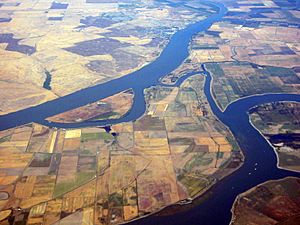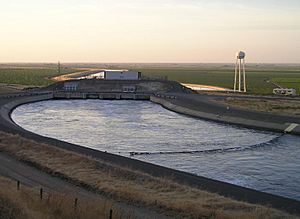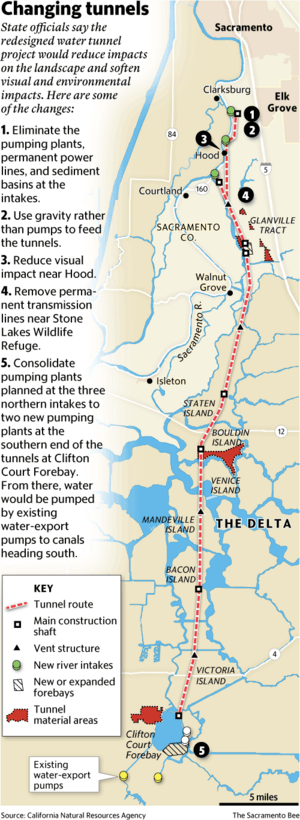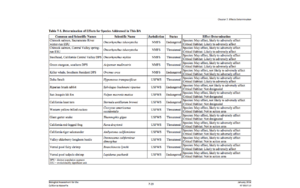California Water Fix and Eco Restore facts for kids
The California Water Fix and Eco Restore is a big plan in California. It used to be called the Bay Delta Conservation Plan. This plan was proposed by former Governor Jerry Brown and the California Department of Water Resources.
The main idea was to build two huge tunnels. These tunnels would carry fresh water from the Sacramento River under the Sacramento-San Joaquin Delta. The water would then go to special stations for the State Water Project and the Central Valley Project.
Each tunnel would be about 150 feet (46 m) deep, 40 feet (12 m) wide, and 30 miles (48 km) long. This tunnel project is as big as or even bigger than the English Channel Tunnel or Boston's Big Dig. The plan also included three new places to take in water. These could collect a lot of water, about 4.9 million acre-feet each year.
The tunnels were expected to cost $15 billion. Another $8 billion was planned for habitat restoration to help nature. The project was supposed to be paid for by the water agencies, farmers, and city water users who would benefit. This meant regular taxpayers wouldn't pay directly. However, an audit in 2017 found that $50 million of taxpayer money was used for the project.
Contents
Why This Project?
For a long time, water from Northern California has been moved to the drier Southern California. This water is important for farms and cities. In the 1960s, Governor Pat Brown started big projects to move water. Later, in the early 1980s, his son, Governor Jerry Brown, tried to build a "Peripheral Canal." But voters did not approve it.
Governor Arnold Schwarzenegger also supported a similar project in 2009. When Jerry Brown became governor again in 2011, he continued pushing for it. The project changed from an above-ground canal to two huge underground tunnels, called the "twin tunnels." These twin tunnels were eventually stopped in 2018. When Governor Gavin Newsom took office in 2019, he started pushing for a single tunnel project instead.
How California Moves Water
California has two main systems for moving water:
- The Central Valley Project (CVP) was finished in the 1970s. It has 600 miles (970 km) of canals. It can move up to 13 million acre-feet (16 km³) of water each year. It also makes electricity. Most of the water from this project (about 80%) goes to farms.
- The State Water Project (SWP) was started in the 1960s by Governor Edmund Pat Brown. It has 700 miles (1,100 km) of canals and can move 5.8 million acre-feet (7.2 km³) of water per year. Most of this water (75%) goes to cities, and 25% goes to farms.
The Peripheral Canal Idea
Before the tunnels, Governor Jerry Brown supported a project called the Peripheral Canal. This canal would have moved water from near Sacramento around the Sacramento-San Joaquin Delta. It would then send the water to Southern California. But voters said no to this plan in 1982.
From Bay Delta Plan to Water Fix

The Water Fix and Eco Restore project was first called the Bay Delta Conservation Plan. When it was first suggested in 2009, it included both building tunnels and restoring the Delta environment. The original plan aimed to restore 100,000 acres (40,000 ha) over 50 years. However, the US Fish and Wildlife Service was concerned that the plan wouldn't help endangered fish like salmon, sturgeon, or delta smelt.
Because of these concerns, the plan for restoring nature was made much smaller. The water supply part was separated and renamed the Water Fix and Eco Restore project. The Eco Restore project now only plans to restore 30,000 acres (12,000 ha) over five years. This part costs $300 million and is paid for by state money.
Who Is Responsible?
Six main agencies are responsible for paying for the project. These include:
- The Santa Clara Valley Water District, which serves 1.9 million people.
- The San Joaquin River Exchange Contractors Water Authority, which serves many farms.
- The San Luis & Delta-Mendota Water Authority, which provides water to farmers.
- The Kern County Water Agency, which serves farms.
- The Westlands Water District, a very large water provider.
- The Metropolitan Water District of Southern California, which serves 19 million city residents. This district is a strong supporter of the tunnels.
What Is the Water Fix?
The Water Fix project was proposed to make California's water system more reliable. It also aims to prepare for problems like climate change and earthquakes.
Right now, water is moved from the Sacramento-San Joaquin Delta to the State Water Project and Central Valley Project. This water flows through many channels before being pumped into big canals. If this water wasn't moved, it would flow into San Francisco Bay. But because so much water is taken out, salt water from the bay can move further inland into the Delta.
The Water Fix plan includes building new tunnels:
- North Tunnels: Three tunnels, each about 14 miles (23 km) long, connecting new water intake spots to an Intermediate Forebay (a holding area).
- Main Tunnels: Two tunnels, about 30 miles (48 km) long, connecting the Intermediate Forebay to the Clifton Court Forebay. These are the "twin tunnels."
The goal of the Water Fix is to make sure water can be moved reliably. It also aims to reduce the environmental stress on the Delta.
The project would be managed by a special "Authority Board." This board would get updates on the construction. Technical experts would advise the board. The director of the Department of Water Resources would have the final say. A special computer system called SCADA would help control and monitor the facilities.
However, the Water Fix plan doesn't solve all water problems. It doesn't fully consider if there will be less water in the Sacramento River in the future. It also doesn't fully explain how to give enough water to fish in the Delta, many of which are already struggling.
What Is Eco Restore?
The Eco Restore plan is designed to lessen any negative effects the California Water Fix might have on the environment. This includes effects from building the tunnels or from their operation.
The Eco Restore plan aims to restore more than 30,000 acres (12,000 ha) of land. This includes:
- 1,000 acres (400 ha) for protecting high ground and habitats linked to flood control.
- 3,500 acres (1,400 ha) for restoring wetlands.
- 9,000 acres (3,600 ha) for tidal and underwater areas.
- 17,500 acres (7,100 ha) for restoring floodplains.
The plan also includes getting special permits that allow for the accidental harm of endangered species, as long as there's a plan to make up for it.
Restoring ecosystems is very important for helping nature recover. The California Water Fix had to go through a biological assessment. This study checks how a project might affect the environment. The table nearby shows some endangered or threatened species that could be affected. It shows that three types of salmon, trout, and sturgeon might be harmed by the project.
The Eco Restore plan has 12 "environmental commitments." These are promises to protect and restore nature. Here are some examples:
| Environmental Commitment | Details |
|---|---|
| Environmental Commitment 3 | Protecting and Restoring Natural Areas
|
| Environmental Commitment 4 | Restoring Tidal Areas
|
| Environmental Commitment 6 | Improving River Banks
|
| Environmental Commitment 8 | Grassland Restoration
|
| Environmental Commitment 9 | Restoring Vernal Pools and Wetlands
|
| Environmental Commitment 10 | Non-tidal Marsh Restoration
|
| Environmental Commitment 11 | Managing and Improving Natural Areas
|
| Environmental Commitment 12 | Managing Methylmercury
|
| Environmental Commitment 15 | Reducing Predatory Fish
|
| Environmental Commitment 16 | Fish Barrier
|
How It's Paid For
The Metropolitan Water District says Southern California gets about 30% of its water from the Delta. This water comes from snowmelt in the Sierra Nevada mountains.
In 2014, the state suggested that water users would pay billions of dollars each year for the project. These payments would continue even during droughts when less water is delivered. The plan was for cities, water agencies, and farmers to pay for the project's debt over 50 years. This would happen even in dry years when they might get little or no water. The Metropolitan Water District claimed it would only cost each homeowner about $5 a month, but they didn't show how they got that number. Critics worry that big projects often cost more than planned.
No Public Vote Needed?
The state planned to pay for the project using bonds issued by the water agencies, not the state itself. If this worked, it wouldn't need approval from the state government or a public vote. However, some agencies that would have to pay for the project said they couldn't afford it if they might end up with less water. In 2016, California voters rejected Proposition 53. This proposition would have required a public vote on any state-backed projects over $2 billion, including the WaterFix.
Financial Concerns
In 2016, the Securities and Exchange Commission fined the Westlands Water District. This was because they misled investors about how drought and water cuts affected their money. This raised concerns about their ability to help pay for the WaterFix project.
Later, an audit was ordered. In September 2017, the audit showed that $50 million of taxpayer money had been used for the project.
Other Big Projects
The WaterFix project is as big as or bigger than the English Channel Tunnel and Boston's Big Dig. Both of these projects ended up costing much more than first expected. The Channel Tunnel cost 80% more than planned. The Boston highway project, the Big Dig, grew from $2.8 billion to over $14.6 billion. This was a huge cost increase, and it also had serious problems.
Is It Worth the Cost?
In 2016, a study by the University of the Pacific looked at the project's benefits versus its costs. It found that for every dollar spent, the project would only provide 23 cents in benefits. In the best case, it would provide 39 cents per dollar. An economist from the university, Jeffrey Michael, said the project wouldn't deliver enough extra water for its high cost.
Laws and the Environment
Some proposed laws could change the future of the California Water Fix and Eco Restore. For example, a bill in the House of Representatives (H.R. 5055) could stop funding for restoration along the San Joaquin River. It could also force more water to be pumped out of the Sacramento-San Joaquin Delta. If this bill passed, there would be no way to fix the damage that might happen.
Another bill, Assembly Bill 1713, would require California voters to approve the Water Fix and Eco Restore project.
How It Affects Nature
Supporters of the project say that new tunnels and habitat restoration would improve the Delta. They believe it would help endangered fish and reduce limits on water exports. They also think pumping water through tunnels would stop salt water from entering the Delta. This is because the pumps wouldn't pull water directly from the Delta anymore. Supporters also believe the project would protect the water system from sea level rise caused by global warming.
However, many people disagree. Opponents worry that the project will reduce the amount of fresh water flowing through the Delta. This could cause more saltwater intrusion. Farmers in the Delta are especially against the project because it would mean less water for their crops. Current water projects have already changed the natural water flow, causing water in the Delta to flow backward and changing its saltiness.
The amount of fresh water flowing to the sea is now about half of what it used to be. To improve water quality, the California State Water Resources Control Board is updating water standards. They suggested allowing up to 40% of the San Joaquin River's water to flow into the Delta during winter and spring. Current rules allow up to 90% of the water to be pumped into canals for Southern California.
Even with environmental rules, pumping water has pulled migrating fish away from their paths. Fish populations like the Delta smelt and Chinook salmon have dropped to very low levels. At least 35 native fish, plants, and animals are now on endangered lists. The Delta smelt might even be close to disappearing.
The Water Fix plan doesn't guarantee how much water the project would provide each year. The original 50-year plan was dropped. Now, the plan relies on yearly environmental permits, which creates uncertainty.
Many environmental groups are against the project or have serious concerns. These include national groups like the Center for Biological Diversity and the National Resources Defense Council. Many state and local groups also oppose it. Cities and farmers in the Delta are against it because they worry it will make their local water quality worse. The project would also fill in 775 acres (314 ha) of wetlands and take over ten years to build.
Delta Islands Purchase
In 2016, the Metropolitan Water District of Southern California decided to buy four Delta islands for $175 million. Many groups challenged this purchase. However, a court decided that it was legal for the water district to buy these islands, as there were no negative effects from the purchase at that time.
Images for kids







